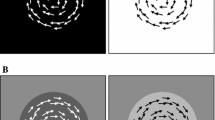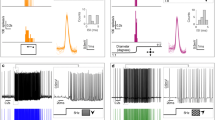Summary
Intracellular recordings were made in the lobula-lobula plate ganglia of the optic lobes of the blowfliesCalliphora erythrocephala, Phaenicia sericata, and the flesh-flySarcophaga (species unknown) with the following results:
-
1.
This region of the optic lobe is electrically very active. A large variety of response types were encountered. We concentrated upon recording from directionally selective movement detectors (DSMD's).
-
2.
We were able to record from all eight classes of DSMD's reported previously from extracellular recordings. We found that it was possible to impale selectively a vertical or a horizontal DSHD, even though these neurons cannot be seen in the live preparation. Recordings were stable for as long as 40 min in cells that subsequent intracellular staining showed to be 2–10 μm in diameter.
-
3.
Iontophoretic injection of the fluorescent dye procion yellow M4RS works very well in this system. We have achieved 100% recovery of injected cells, with partial fills being a rarity.
-
4.
To date all DSMD's were elements of the lobula plate.
-
5.
DSMD's with preferred directions in the horizontal plane lie in the anterior portion of the lobula plate and project to the ventral periesophageal region. The anatomical “horizontal system” described by Pierantoni (1973) and Strausfeld (1975) are horizontal DSMD's. Smaller cells, mimetic to the “horizontal system” are also horizontal DSMD's. Wide-field cells (Strausfeld, 1970, 1975) may be horizontal DSMD's.
-
6.
DSMD's with preferred directions in the vertical plane lie in the posterior region of the lobula plate and project to the dorsal periesophageal region. These cells are a system of small diameter (2–4 μm) elements that are in close association with a system of larger cells (“vertical system”) described by Pierantoni (1973) and Strausfeld (1975).
-
7.
Intracellular recordings established directly that some horizontal and vertical DSMD's have binocular visual fields.
Similar content being viewed by others
References
Bishop, L. G., Keehn, D. G.: Neural correlates of the optomotor response in the fly. Kybernetik3, 288–295 (1967)
Bishop, L. G., Keehn, D. G., McCann, G. D.: Studies of motion detection by interneurons of the optic lobes and brain of the fliesCalliphora phoenicia andMusca domestica. J. Neurophysiol.31, 509–525 (1968)
Burrows, M., Rowell, C. H. F.: Connections between descending interneurons and metathoracic motoneurons in the locust. J. comp. Physiol.85, 221–234 (1973)
Dvorak, D. R., Bishop, L. G., Eckert, H. E.: Intracellular recording and staining of directionally selective motion detecting neurons in fly optic lobe. Vision Res.14, in press (1974)
Dvorak, D. R., Bishop, L. G., Eckert, H. E.: Intracellular recording and staining of optomotor neurons in fly optic lobe. Fourth Annual Meeting, Society for Neuroscience, St. Louis, Mo., Oct. (Abstract) 1974
Mimura, K.: Integration and analysis of movement information by the visual system of flies. Nature (Lond.)226, 964–966 (1970)
Mimura, K.: Neural mechanisms subserving directional selectivity of movement in the optic lobe of the fly. J. comp. Physiol.80, 409–437 (1972)
Murphy, R. K.: Characterization of an insect neuron which cannot be visualizedin situ. In: Intracellular staining in neurobiology, p. 135–150 (Kater and Nicholson, eds.). Berlin-Heidelberg-New York: Springer 1973
O'Shea, M., Williams, J. L. D.: The anatomy and output connection of a locust visual interneurone; the lobula giant movement detector (LGMD) neurone. J. comp. Physiol.91, 257–266 (1974)
O'Shea, M., Rowell, C. H. F., Williams, J. L. D.: The anatomy of a locust visual interneurone; the descending contralateral movement detector. J. exp. Biol.60, in press (1974)
Pierantoni, R.: An observation on the giant fiber posterior optic tract in the fly. Biocybernetics Congress, Leipzig, 1973
Rowell, C. H. F.: The orthopteran descending movement detector (DMD) neurons: a characterization and review. Z. vergl. Physiol.73, 167–194 (1971)
Strausfeld, N. J.: Golgi studies on insects. Part II. The optic lobes of Diptera. Phil. Trans. B258, 135–223 (1970)
Strausfeld, N. J.: Atlas of an insect brain. Berlin-Heidelberg-New York: Springer 1975
Author information
Authors and Affiliations
Additional information
We thank Dr. R. Pierantoni (Consiglio Nazionale delle Ricerche, Laboratorio di Cibernetica e Biofisica, Camogli, Italy) for helpful discussions and correspondence relevant to the identification of movement detecting cells. We thank Dr. N. J. Strausfeld (Max-Planck-Institut für Biologische Kybernetik, Tübingen, W. Germany) for reviewing some stained material and providing drawings made from silver impregnated material; we are most thankful for his detailed correspondence regarding the geometrical relationships of the large cells of the lobula plate. We thank Barbara Henon for her critical reading of the manuscript, John Wilson for expert construction of experimental apparati, and Jack Eppinger for his expertness in photography.
Supported by grants AFOSR-71-2112 and NSF GB30733.
Rights and permissions
About this article
Cite this article
Dvorak, D.R., Bishop, L.G. & Eckert, H.E. On the identification of movement detectors in the fly optic lobe. J. Comp. Physiol. 100, 5–23 (1975). https://doi.org/10.1007/BF00623928
Received:
Issue Date:
DOI: https://doi.org/10.1007/BF00623928




